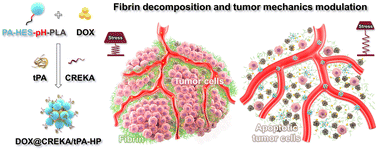Precise fibrin decomposition and tumor mechanics modulation with hydroxyethyl starch-based smart nanomedicine for enhanced antitumor efficacy†
Abstract
Chemotherapy is a conventional cancer treatment in clinical settings. Although numerous nano drug delivery systems have been developed, the chemotherapeutic effect is greatly limited by abnormal tumor mechanics in solid tumors. Tumor stiffening and accumulated solid stress compress blood vessels and inhibit drug delivery to tumor cells, becoming critical challenges for chemotherapy. By loading doxorubicin (DOX), tissue plasminogen activator (tPA), and fibrin targeting peptide CREKA (Cys–Arg–Glu–Lys–Ala) within pH responsive amphiphilic block polymers, pyridyldithio-hydroxyethyl starch-Schiff base-polylactic acid (PA–HES–pH–PLA), we report a smart nanomedicine, DOX@CREKA/tPA–HES–pH–PLA (DOX@CREKA/tPA–HP), which exhibits a potent antitumor efficacy. In triple-negative breast cancer (TNBC) 4T1 tumors, DOX@CREKA/tPA–HP precisely targeted and effectively decomposed fibrin matrix. By measuring Young's Modulus of tumor slices and quantifying tumor openings, we demonstrated that DOX@CREKA/tPA–HP remarkably reduced tumor stiffness and solid stress. Consequently, the alleviated tumor mechanics decompressed tumor blood vessels, promoted drug delivery, and led to amplified antitumor effect. Our work reveals that decomposing fibrin is a significant means for modulating tumor mechanics, and DOX@CREKA/tPA–HP is a promising smart nanomedicine for treating TNBC.



 Please wait while we load your content...
Please wait while we load your content...